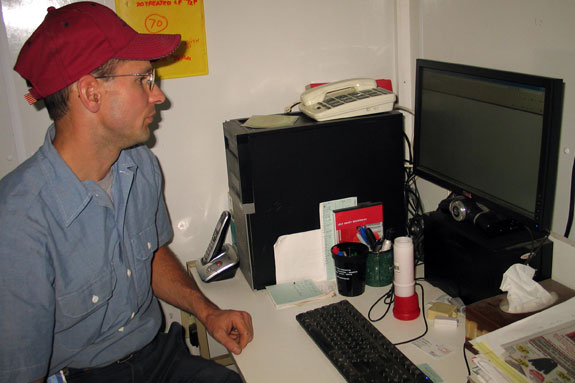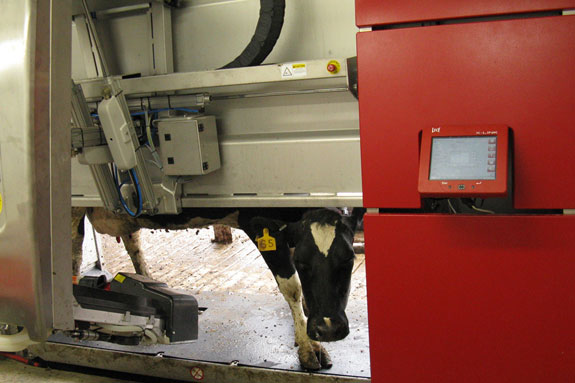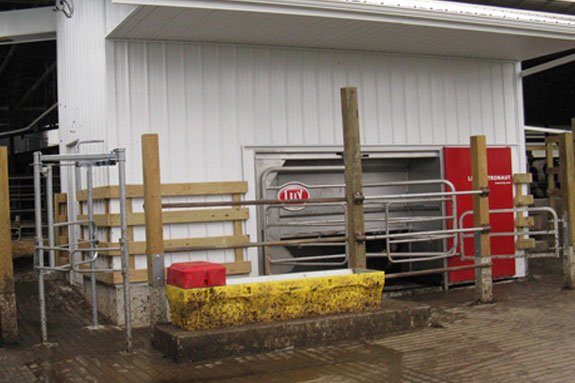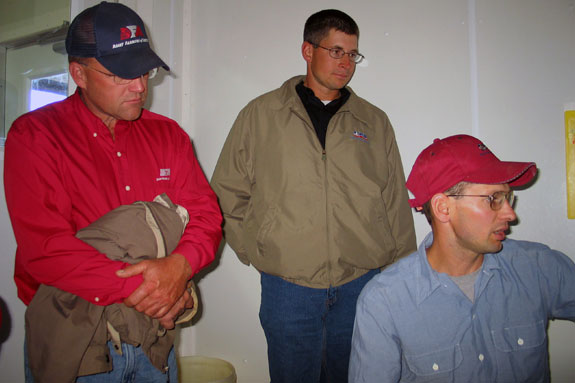to jump to the article. Summary: In a February e-newsletter, we reprinted an article from Dairy Farmers of America's Mideast Area Council, featuring Joe Ramsier and two recently installed Lely robots on his Rittman, Ohio, dairy. We asked Ramsier to provide some insight on his decision to make the change in his operation. We recently learned that Ramsier's dairy suffered a barn fire in July, resulting in the loss of the main barn, one of the robots, the milkhouse and office, as well as several pieces of equipment. Ramsier remains positive as his family begins to rebuild the operation. "Thankfully no animals or people were hurt or lost," he told us in an email. Because this article was so popular, we asked Ramsier and a Lely representative follow-up questions: Q: What is another example of new technology you're looking to implement?
A : One example is an online automatic backup service. The service is very cheap (sometimes even free) and an invaluable source of off-site data storage. Thankfully in our fire we only lost 1.5 days of data, but if I would have had an online backup setup we would have lost virtually no data. I would recommend anyone who has their data on computer to consider an off-site backup service. If your hard drive crashes then your backup on your memory stick you leave in the computer helps, but if you have a fire or someone steals your computer that memory stick may go with it.
—Joe Ramsier, dairy producer, Ohio
Q : To date, how many U.S. producers have installed Lely robotic milking equipment? What's the number one positive comment you hear from producers after switching to a robotic milker system?
A : Lely has hundreds of Astronaut robotic milking systems running in the U.S. and over 12,500 Astronauts running around the world. While we receive many positive comments from producers after they have switched to a robotic milking system, the most common benefit we hear is how the producers and their families now have the flexibility to choose how they spend their time, rather than the twice- or three times-a-day milking.
One producer shared that with Lely’s Astronaut milking their herd 24 hours a day, it freed up a lot more time for their family. Just the day before, they went to a family barbeque which, prior to the Astronaut, was unheard of. Another producer said that after installing the Astronaut on their farm, they could take off to see their grandkids more often.
It's always a pleasure to hear how Lely's Astronaut robotic milking system benefits producers.
—Chad Huyser, Director of Sales & Operations, Lely USA, Iowa
[Click here or on the image above right to see the full list of the Top 25 articles of 2011. Click here to see the list from 2010.]
ARTICLE

The following article is reprinted with permission from the October/November 2010 DFA Mideast Industry Insider . In this story, you'll read about Joe Ramsier, who installed two Lely robotic milkers on his Rittman, Ohio, dairy. .
Progressive Dairyman asked Ramsier, pictured at right, a few follow-up questions regarding the decision to make a change in his operation.
Q. Why is it important for producers to be open to new technology, such as robotic milkers?
RAMSIER : New technology can help today's dairyman become more efficient in today's economy as well as provide the cows the consistency that they can thrive on. Robot milkers can also provide the relief of some of the daily milking routine and give timeflexibility that the small farmer and his family can benefit from.
Q. What advice do you have for producers looking into robotic milkers for their operations?
RAMSIER : Look at other farms with robotsand ask a lot of questions. Don't assume that "this will not work with my cows."
Q. Larry Alexander is quoted in this article as saying, "It just goes to show that progressive doesn't always have to be large." Would you agree with that statement?
RAMSIER: "Progressive" can have a lot of meanings both good and bad. However, I thinkwhat Larry meant is that notonly large farms can benefit from technology ... some technology actually can fit the small farmer quite well and he may be able to benefit from it more than the large farmer. PD
ARTICLE
During their October 2010 Council meeting, Mideast Area Council members visited a local DFA dairy farm that embraces technology in an effort to reduce labor costs as well as improve the family’s quality of life.

Joe Ramsier, his son Kenny, and his parents, Marvin and Terri, demonstrated their two Lely robotic milkers on their Rittman, Ohio, farm.
Since installing the robots in April, the family has noticed a production increase as the 110-cow herd went from being milked twice a day to averaging just over three milkings per cow per day.
Their quality continues to improve and they report treating fewer cases of mastitis since the switch.
"We decided we were at the right place in our operation to take advantage of technology and make a change," says Joe Ramsier. "We have always produced high-quality milk and taken good care of our animals. However, we wanted to spend more time with our families."

The robotic milking parlor is a self-contained modular unit with four connections: communications, electric, water and a 1-inch milk line.
Since the cows voluntarily enter the milking units any time 24-hours a day, the Ramsiers installed two 60-animal parlors right in the cows’ living area, with minimal construction.
They cut a hole in one side of the barn and built a 10 x 20-foot room for one unit. For good cow-flow traffic, they installed the second unit at the opposite end of the facility.
Most of the cows quickly adapted to the robotic milking system and may enter a unit multiple times a day.
Each cow wears a computer strap around her neck, and when she enters the milking station, more than 100 points of information are recorded and analyzed during her milking session.
If a cow enters the unit in less than eight hours and the computer calculates that the udder does not have enough milk in it, the robot sends her back out without either milking or feeding her.
The robot brushes and sanitizes the udder before a laser guides the milk claw onto the cow’s teats. Her milk temperature and quantity are recorded, along with her weight. Milk is analyzed during the milking from each quarter for signs of mastitis, off-color, conductivity or other problems.

The computer responds to any treated cow, fresh cow or mastitis issues and dumps the milk from any cow that shows a problem.
The milk claw is steam-sanitized and rinsed between every cow, so there can be no cross-contamination. The robot is also programmed to shut down and clean the entire system twice every day.
Other information, such as how she chews her cud and her activity level compared to past history, is downloaded during the milking session.
"We can review the data on each cow and analyze any changes so we can respond immediately to anything from a quality issue to breeding-readiness and to whether a cow is off her feed," says Ramsier.
The family finds a number of cost savings with the new milking system.
"Feed costs are more efficiently spread out among the cows. We can entice the cows into the robot with some food. We’ve taken some grain out of the TMR and created a special grain-based protein pellet that is a part of each cow’s ration.
The high milk producers receive more feed than the low milk producers. The robot trickle feeds the pellets during milking because the cows eat better with a little bit at a time than if they have a whole bowl at one time," says Ramsier.
They also use fewer chemicals in the pipeline washing, a little more teat dip because it is sprayed on, less electricity and considerably less water than in the previous milking parlor, which they no longer use.
"We figure each robot saves 40 hours of work each week, so we have a labor cost savings of approximately 80 hours a week," he says. "But now, our time is more flexible. We wash and service the robots, feed, scrape and do the daily chores around the crop farming, at our own convenience."
How do the Ramsiers know that the robotic milking system is working well for their herd?
"The way the herd acts. The cows are obviously calmer," says Ramsier. "We can walk into the area and work with one cow and the other cows just don’t pay much attention to us."
In addition, he says that the cows are each producing about five more pounds per day with the increased milking frequency.
"We used to milk on a rigid two-times-a-day schedule, but now most cows average more than three milkings a day by their own choice."
"We really appreciated the opportunity to visit the Ramsier’s farm, which is a very nice facility," says their council member, Larry Alexander of Big Prairie, Ohio. "It was enjoyable and educational. I’m proud the Ramsiers chose to be members of DFA. They are a great example of a family operation that is taking advantage of the latest technology. It just goes to show that progressive doesn’t always have to be large." PD
PHOTOS
TOP RIGHT: J oe Ramsier demonstrates his robotic milking system. Photo provided by Jane Sweet and Heather Schofield.
TOP LEFT:Since installing the robots in April 2010, the Ramsier family has noticed a production increase as the 110-cow herd went from being milked twice a day to averaging just over three milkings per cow per day. Photo provided by Joe Ramsier.
MIDDLE RIGHT:The Ramsiers cut a hole in one side of the barn and built a 10 x 20-foot room for one unit. For good cow-flow traffic, they installed the second unit at the opposite end of the facility. Photo provided by Joe Ramsier.
MIDDLE LEFT: Joe Ramsier (right) explains the computer responses to Doug Krickenbarger, Mideast Area CouncilCouncil member (left) and Tim Roell, Young Cooperator Council Liaison (middle). Photo provided by Jane Sweet and Heather Schofield.
CAPTION 2: Joe Ramsier demonstrates his robotic milking system. Photos provided by Jane Sweet and Heather Schofield
-
Jane Sweet
- Dairy Farmers of America, Mideast Area
- Email Jane Sweet

-
Heather Schofield
- Dairy Farmers of America, Mideast Area
- Email Heather Schofield






